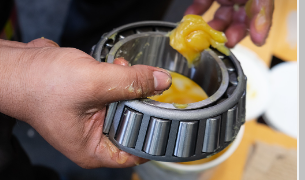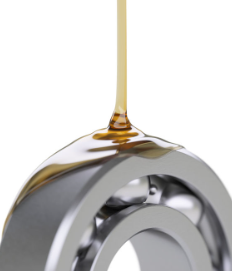3 Steps to"How to lubricate ball bearings"
Learn the three essential steps to lubricating ball bearings for optimal performance and longevity.
Ensure your bearings are functioning correctly with this guide.
Ball bearings are a critical component of mechanical systems, and proper lubrication is crucial for their longevity and smooth operation.
In this article, we will discuss the three essential steps for how lubricating ball bearings and ensuring optimal performance.
Step 1. Preparing for lubrication
Step 2. Applying lubricant
Step 3. Testing the bearing
From preparing for lubrication to testing the bearing, we have everything you need to know to properly lubricate your ball bearings and keep them running smoothly.
Types of lubricants

Lubrication plays a crucial role in reducing friction and wears in mechanical systems, including ball bearings.
Lubricants are used to separate the surfaces of the bearing, reducing the amount of friction generated.
There are several types of lubricants available for use in ball bearings, each with its advantages and disadvantages.
In this article, we will explore the different types of lubricants commonly used for ball bearings and the pros and cons of each.
Mineral oil lubricants:
Mineral oil is a petroleum-based lubricant that is widely used in ball bearings.
This type of lubricant provides excellent lubrication, and its properties can be modified to suit various applications.
The pros of mineral oil lubricants are that they have good lubricating properties, are widely available, and are relatively inexpensive.
The cons are that they can break down over time, leading to reduced lubrication, and they can be prone to oxidation.
Synthetic oil lubricants:
Synthetic oils are artificially created lubricants that provide better performance than mineral oils.
These lubricants are made from a range of materials, including esters, polyglycerols, and silicones.
Synthetic oils are known for their ability to resist breakdown and oxidation, and they offer excellent lubrication even at high temperatures.
The pros of synthetic oil lubricants are that they provide excellent performance, have a long lifespan, and offer superior resistance to breakdown and oxidation.
The cons are that they can be more expensive than mineral oils and may not be suitable for all applications.
Grease lubricants:
Grease is a semi-solid lubricant that is made by mixing a base oil with a thickener.
The thickener used in grease lubricants can be made from a variety of materials, including lithium, calcium, and aluminum.
Grease lubricants are ideal for applications where there is a need for long-lasting lubrication, as they remain in place even when the bearing is not in use.
The pros of grease lubricants are that they provide long-lasting lubrication, are easy to apply, and can be used in a wide range of applications.
The cons are that they can be more difficult to apply than liquid lubricants, and their viscosity can change with temperature.
Solid lubricants:
Solid lubricants, such as graphite and molybdenum disulfide, are used in applications where liquid lubricants are not practical.
These lubricants are applied as a thin film on the bearing surface and provide long-lasting lubrication.
The pros of solid lubricants are that they provide long-lasting lubrication, are suitable for high-temperature applications, and do not require constant reapplication.
The cons are that they can be difficult to apply, can cause contamination, and may not be suitable for all applications.
Dry lubricants:
Dry lubricants, such as PTFE and graphite, are used in applications where liquid lubricants are not practical or where cleanliness is essential.
These lubricants are applied as a dry film on the bearing surface and provide long-lasting lubrication.
The pros of dry lubricants are that they provide long-lasting lubrication, do not attract dirt or dust, and are suitable for high-temperature applications.
The cons are that they can be difficult to apply and may not be suitable for all applications.
There are several types of lubricants available for use in ball bearings, each with its advantages and disadvantages.
The choice of lubricant will depend on the specific application, the operating conditions, and the desired performance.
When selecting a lubricant, it is essential to consider factors such as temperature, load, speed, and environmental conditions.
Proper lubrication is crucial for the smooth operation of ball bearings, and choosing the right lubricant is an important step in ensuring the longevity and performance of mechanical systems.
3 Steps to"How to lubricate ball bearings"

Ball bearings are an essential component of mechanical systems, and proper lubrication is crucial for their longevity and smooth operation.
In this article, we will discuss the three steps for how to lubricate ball bearings: preparing for lubrication, applying lubricant, and testing the bearing.
Step 1. Preparing for lubrication
Before beginning the lubrication process, it is essential to take appropriate safety precautions.
When handling ball bearings, always wear protective gloves and eyewear to prevent injury.
Additionally, it is crucial to remove the bearing from its housing to ensure that it can be adequately lubricated.
Once the bearing is removed from its housing, it should be thoroughly cleaned to remove any dirt, debris, or old lubricant.
Use a clean cloth or a brush to wipe away any dirt or debris from the bearing.
Then, use a solvent, such as an isopropyl alcohol or mineral spirits, to remove any old lubricant from the bearing.
Allow the bearing to dry completely before moving on to the next step.
Step 2. Applying lubricant
Choosing the right amount of lubricant is crucial for ensuring the optimal performance of ball bearings.
Too little lubricant can result in increased friction and wear, while too much lubricant can cause the bearing to overheat and fail prematurely.
The amount of lubricant required will depend on the size of the bearing, the application, and the operating conditions.
Once the appropriate amount of lubricant has been determined, it is time to apply the lubricant to the bearing.
Begin by applying a small amount of lubricant to the palm of your hand or a clean surface.
Then, using a brush or your finger, apply the lubricant evenly to the bearing, ensuring that all surfaces are covered.
After applying the lubricant, it is time to reinstall the bearing in its housing.
Be sure to align the bearing correctly and tighten any fasteners to the manufacturer's specifications.
Step 3. Testing the bearing
Once the bearing has been lubricated and reinstalled, it is crucial to test it to ensure that it is functioning correctly.
To do this, spin the bearing by hand or using a specialized tool.
The bearing should spin smoothly and quietly without any signs of binding or resistance.
If any issues or abnormalities are detected during testing, it may be necessary to repeat the lubrication process or investigate further to identify and address the problem.
It is essential to monitor the bearing regularly for signs of wear or failure and to perform routine maintenance as necessary to ensure its continued performance.
Proper lubrication is essential for the smooth operation and longevity of ball bearings.
By following the three steps of preparing for lubrication, applying lubricant, and testing the bearing, you can ensure that your ball bearings are adequately lubricated and functioning correctly.
Remember to take appropriate safety precautions, choose the right amount of lubricant, and test the bearing regularly to identify and address any issues that may arise.
With proper lubrication and maintenance, your ball bearings can provide reliable performance for years to come.
Conclusion

Proper lubrication is essential for the smooth operation and longevity of ball bearings.
By following our guide, you can ensure that your ball bearings are adequately lubricated and functioning correctly, providing reliable performance for years to come.





